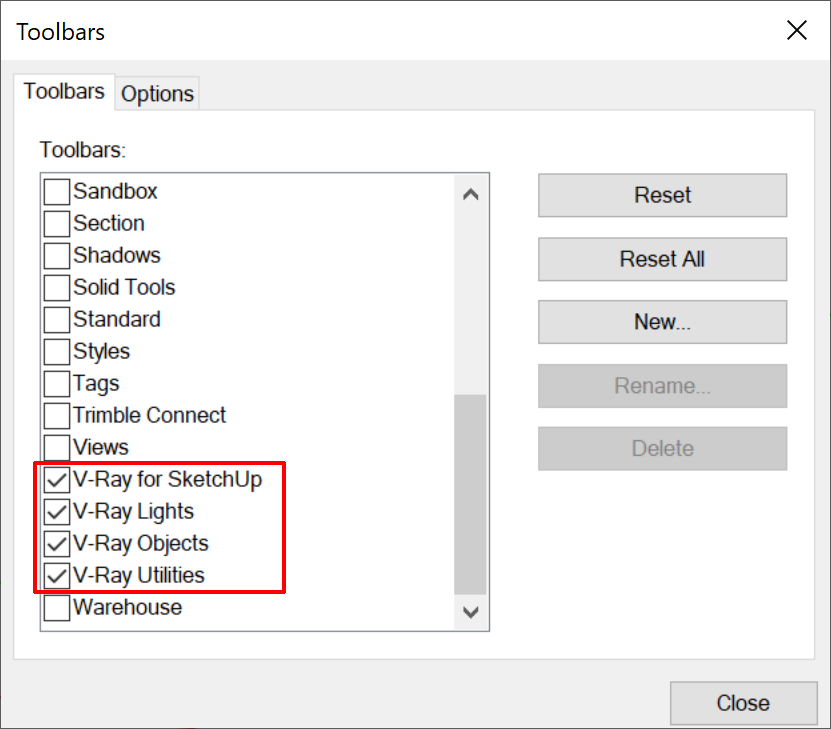This page provides details on the V-Ray Toolbar.
Overview
V-Ray includes a toolbar with easy shortcuts to some of the most commonly used V-Ray components. By default the toolbar consists of four floating toolbars, that can be docked where needed in the SketchUp interface. The V-Ray Toolbars can be easily pulled from any docked position to either a horizontal or vertical toolbar by pulling at the top end of each toolbar.
They can be added by clicking on the View window -> Toolbar.
Toolbar Functions
The V-Ray toolbar provides the functions listed below. Note that all buttons check if V-Ray (or respectively V-Ray Interactive) is the current renderer, and if not, will prompt you to set the renderer to V-Ray. When you click on the V-Ray (or respectively V-Ray Interactive) button in the toolbar the icon background changes color. The render buttons can be clicked again to stop a render.
| Button | Description |
|---|---|
| Shows the Asset Editor window | |
| Starts or stops a non-Interactive render. | |
| Starts or stops an Interactive Render. | |
| Exports and renders the current scene with the Chaos Cloud. | |
| Starts V-Ray Vision. | |
| Triggers an Interactive render in the SketchUp viewport. | |
| Allows render regions to be selected in the viewport. | |
| Shows the V-Ray Frame Buffer (VFB). | |
| Starts or stops a Batch Render. This iterates through all scenes of the SketchUp project and renders them one by one. | |
| Starts a Cloud Batch Render. This iterates through all scenes of the SketchUp project and uploads them to the Chaos Cloud for rendering. Submitting a batch of render jobs to Chaos Cloud is currently not available. | |
| Allows the camera to move without updating the render view during Interactive Rendering. | |
| Starts V-Ray Light Gen. | |
| Activates the Rectangle Light tool. Click and drag in a viewport to create the light. | |
| Activates the Sphere Light tool. Click and drag in a viewport to create the light. | |
| Activates the Spotlight tool. Click and select a point in a viewport to create the light. | |
| Activates the IES Light tool. Click and drag in a viewport to create the light. | |
| Activates the Omni Light tool. Click in a viewport to create the light. | |
| Activates the Dome Light tool. Click in a viewport to create the light. | |
| Creates a Mesh Light. Converts the selected Group or Component into a V-Ray Mesh Light object. | |
| Adjusts the light intensity by click-dragging over a light source in the viewport. | |
| Creates an Infinite Plane object. Click in a viewport to create the object. | |
| Exports the selected Group or Component as a .vrmesh file. Optionally, replaces selection with the created V-Ray Proxy. | |
| Imports a .vrmesh file as a V-Ray Proxy object in the scene. | |
| Converts the selected Group or Component into a V-Ray Fur object. | |
Creates a Clipper Plane. Converts the selected Group or Component into a V-Ray Mesh Clipper object. | |
| Add V-Ray Displacement to the selected Group or Component. | |
| Enables the use of faces for the viewport widgets. Only lines are used when this option is disabled. |
| Hides V-Ray Lights, Fur, Proxies, Infinite Plane and Mesh Clipper widgets from the viewport. This option does not affect rendering. This option provides a cleaner export to LayOut without any unnecessary V-Ray widgets and preview geometries. | |
| Removes the material from the currently selected face, group or component and all its children. | |
| Modifies the texture placement for the selected objects. A cubic projection is used with texture size independent of object scaling. | |
| Modifies the texture placement for the selected objects. A cubic projection is used with texture scaled to match objects bounding box size. | |
| Modifies the texture placement for the selected objects. A spherical projection1 with texture size independent of object scaling. | |
| Modifies the texture placement for the selected objects. A spherical projection with texture scaled to match objects bounding box size. | |
| Activates a tool for inspecting scene hierarchy, material and V-Ray Object ID assignments. Hold down Shift while hovering to select parent group or component definitions. Hold down Shift while hovering and left mouse click to select a material assigned to any group or component in the current hierarchy. The tool can also be used for interactive light intensity manipulation. |
Footnotes
1 – When applying Spherical projection only to specific faces of an object, the mapping will not be properly set. This generally occurs with faces aligned along the X or Y axes.

































